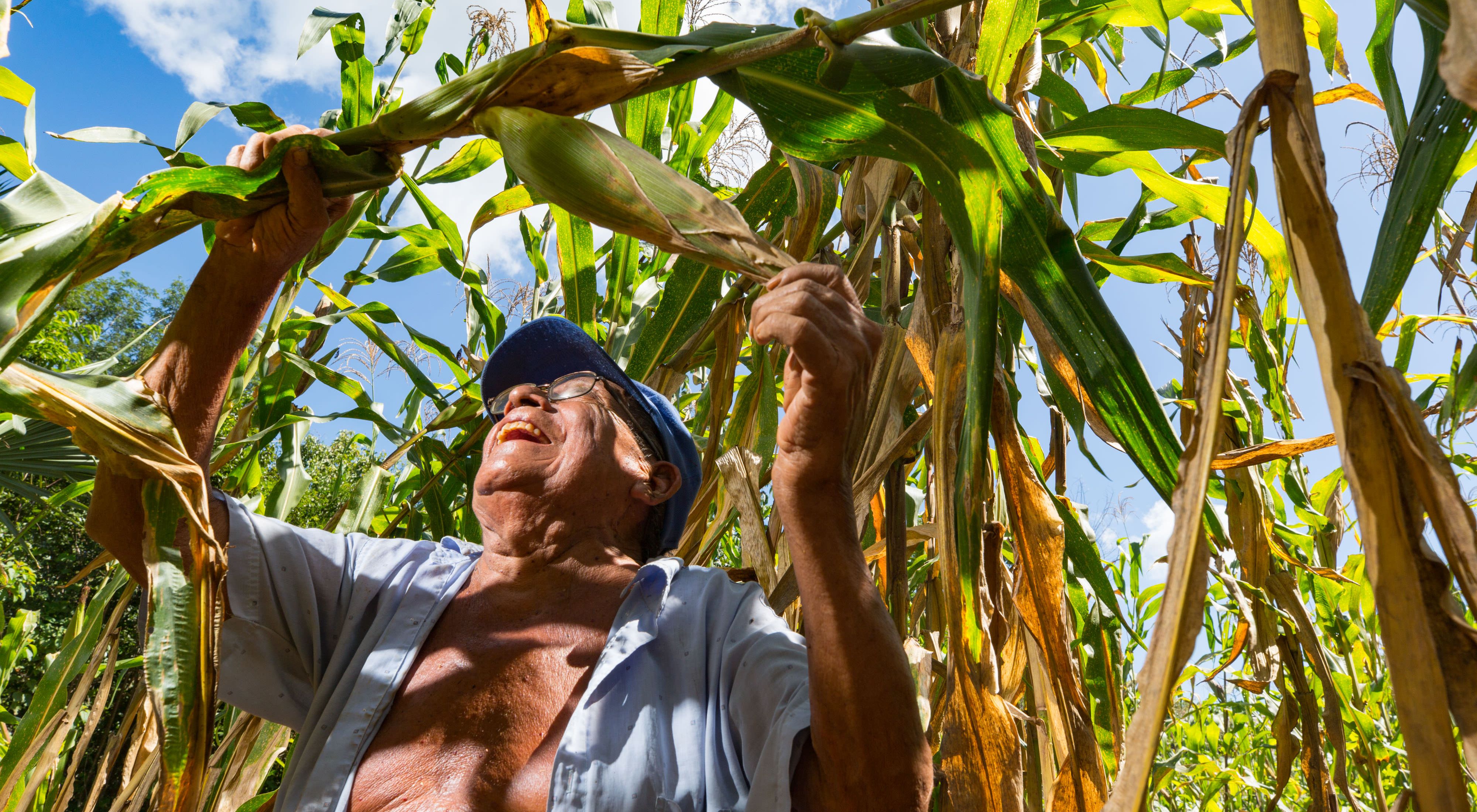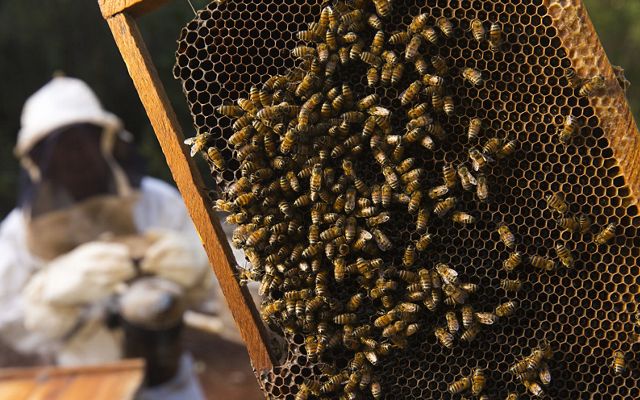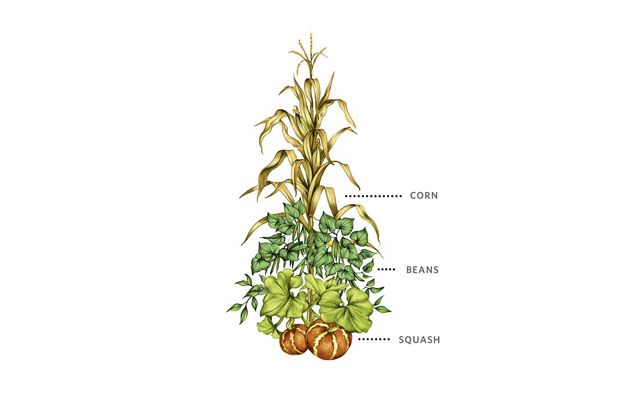Maya Gold
Mixing ancient farming practices with modern science is saving forests in Mexico and producing better crops.
Fall 2017
Mexico’s Yucatan Peninsula is a sprawling, 50,000-square-mile expanse of rocky jungle famed for Maya ruins and brilliant blue “cenotes,” limestone sinkholes that dot the landscape like jewels. Just outside the hardscrabble town of San Agustin, Audomaro Canul stands in a field of corn, beans and squash. Slight and wiry with a faint goatee, Canul has an air of soft-spoken patience.
Canul and most other people in the Yucatan are ethnically and linguistically Mayan. Their culture has been on this land for millennia, and the sense of tradition is strong. Each year, in late spring, many villagers here ask a local shaman to perform “ch’a chaak,” the traditional rain ceremony. And in the past, Canul says, the rains were always dependable.
“We were certain that it would rain between the third and 10th of May,” he says. “Even if the soil was dry, we would still plant, because we knew the rains would come.” Those days are over now. “When it’s the rainy season, it doesn’t rain. And during the dry season, now it rains,” Canul says. “Climate change is having an impact on all of us.”
That has spurred a profound sense of crisis. Canul and some three-quarters of a million rural Yucatecans are trying to adapt to keep pace with climate change. Paradoxically, however, this moment is also letting them play a pivotal role in the effort to protect a vast natural storehouse of carbon.
The heart of Maya culture is the thick, steamy forest, known locally as “el monte,” that covers the peninsula. With hundreds of species of trees, the forest is home to awe-inspiring animals like jaguars and pumas, and is the source of the healing plants and herbs traditionally used by the Mayas. And the more than 25 million acres of forest here in Mexico are part of the larger, 38-million-acre Selva Maya, which covers portions of Belize and Guatemala, and—after the Amazon—is the second-largest remaining tropical rainforest in the Americas.
The farms and ranches here are carved from this forest. But now, The Nature Conservancy is working with 82 communities across the Yucatan Peninsula to stop deforestation. The goal is better crop, cattle and logging yields, which will allow farmers, ranchers and loggers to clear less forest. To a large extent, the key to success here lies in promoting systems of growing food that have already evolved over thousands of years to succeed in this landscape—and enhancing them to work even when the rains are unpredictable.

The Nature Conservancy began working in the Yucatan Peninsula some 30 years ago. The organization helped protect now-iconic areas like the Calakmul Biosphere Reserve, centered around a significant Maya archaeological site in the southern part of the peninsula, and the Sian Ka’an Biosphere Reserve, along the Caribbean coast near Tulum. Those efforts, in turn, led to the creation of a nationwide network of federally protected areas.
“But all around the protected areas, there was rapid deforestation going on,” says Rane Cortez, the director of TNC’s lands program in Mexico and northern Central America. “And so that’s when we started to really think about addressing these drivers of deforestation.”
Deforestation here—some 200,000 acres per year—is not primarily driven by logging. Roughly a third of the problem is caused by farmers cutting and burning the forest to open new fields; half is driven by ranchers clearing the forest for cattle.
Historically, a farmer would cut down and burn patches of forest large enough for his family’s crop. He would clear a plot of land, using it for planting until the soil nutrients were depleted, at which point he would move on, clear a new patch and let the forest regrow over his old land in a roughly 25-year rotational cycle. Recently, however, people here have been using the land much more extensively, to the point that sometimes they must clear more forest after just seven years. There has also been a shift toward larger, permanently market-oriented cornfields.
In 2011, TNC began helping farmers and ranchers take the pressure off the forest. The key is what scientists call “sustainable intensification” of local agricultural practices: boosting farmers’ and ranchers’ yields per acre so they may require a smaller footprint.
“If you can’t stop the expansion of farming and ranching, then you’re not going to stop deforestation,” says Cortez. “The basic premise is, let’s make it more intensified so it doesn’t keep expanding.”

One morning in late July, Cortez starts a two-hour drive south from Merida, the capital of Yucatan state, deep into el monte. She’s a Minnesota native who has spent a decade splitting her time between on-the-ground work in Brazil and Mexico and climate-policy development at TNC’s headquarters outside Washington, D.C. Cortez is joined by Sebastien Proust, a Frenchman by birth who specializes in forests and climate change. Proust has lived in Mexico for 14 years, gained Mexican citizenship along the way and keeps his own Maya-style experimental minifarm just outside Merida.
The drive takes Cortez and Proust into a world far different from that of coastal tourist hot spots like Cancun. In these remote areas, people truly support themselves from the land. Subsistence farming is the bedrock of life: What little cash people earn comes from selling corn to tortilla producers; vegetables to a market roughly 20 miles away; honey, which is largely exported to Germany; and, occasionally, community-owned timber.
“When you ask what they do, they are ‘campesinos,’” says Proust. “And being a campesino means doing a little bit of everything.”
Cortez and Proust meet Canul on his 7.5-acre farm just outside San Agustin. Compared with a crisp, laser-straight Midwestern cornfield, Canul’s unruly plot of corn, beans and squash feels like a vegetal riot. Yet it has its own beauty, unpolished though it may seem.
This is the traditional Yucatecan farming system, known as “la milpa,” which evolved over roughly 4,000 years. Farmers grow corn, beans, squash and other food plants together in a kind of agricultural scrap quilt; tolerate edible “weedy” greens in their fields; and use the surrounding forest for beekeeping and honey production. Additionally, many farmers grow a variety of fruit, including pineapple, bananas and guanabana, for the market in a TNC-supported agroforestry project.



Maya identity has, in many ways, been inseparable from the milpa, but plantation farming and corn monocrops have also become part of the regional farming landscape. While many Mayas never completely let go of milpa farming, it has become harder to keep the practice alive.
Each year in early May, in a traditional practice called “tikin muuk,” farmers would plant their seeds in dry soil with confidence that the rains would soon follow. Things have been different lately, and the previous two years were especially tough.
“We lost a lot,” says Canul. He stoically recites the litany: “Squash. Pumpkins. Beans. Chiles. Tomatoes.”
The need to adapt quickly to keep pace with the changing climate is driving a fusion of traditional and more modern practices here. In 2014, with help from TNC and its local partners, farmers in a nearby town named Francisco J. Mujica began experimenting with conservation tillage, a strategy to replenish the soil’s nutrients.
Only in the first year of a four-year cycle do farmers till their fields, plowing deeply to break up the soil. Then, as they harvest each crop, the farmers leave the stubble on the field, creating a mulch that adds nutrients back into the soil. The process increases organic matter and provides additional structure to slow evaporation and retain soil moisture.
Within one year, farmers saw a 35 percent increase in yield. Word quickly spread. Canul went to the town of Mujica to see for himself, and came home impressed. And in the first year of conservation tillage, one farmer in San Agustin saw a fivefold increase per acre in his corn yield.
“The whole idea here is to focus back on the soil,” says Proust. “What makes a good plant is good soil.” He adds that with good soil, good plants and good territorial planning tools, farmers won’t need to expand farther into the forest.

Slowing the rate at which the forest is cleared will have positive effects far beyond the Yucatan. Worldwide, tropical deforestation accounts for about 15 percent of annual greenhouse gas emissions. But if the planet’s tropical forests can be left largely untouched, a significant quantity of emissions can be kept out of the atmosphere.
To make that happen, a growing global network of projects designed to reduce emissions from deforestation and forest degradation—a concept known in shorthand form as REDD+—is focused on better managing forests in more than 60 developing countries. For the past six years, TNC has, thanks to a $29 million grant from the U.S. Agency for International Development, laid the foundation for a massive REDD+ program in Mexico.
Mexico is now poised to receive up to $60 million from the World Bank’s Carbon Fund, an international mechanism that pays tropical forest countries for carbon emissions reductions through forest protection. The money will be invested to help farmers intensify their yields so they don’t have to clear new forest; help ranchers to improve the productivity of their ranches; or help loggers use reduced-impact logging techniques.
And in this respect, the Selva Maya has a lot to offer. The portion of the forest on the Yucatan Peninsula alone stores more than 173 million tons of carbon. In late 2016, governors of the three Yucatan states committed to a goal of net-zero deforestation on the peninsula by 2030, primarily through sustainable intensification of agriculture and cattle ranching, plus reforestation. By 2030, those changes could annually lock an additional 5 million tons of carbon dioxide in the forest.
Thanks to that commitment, Mexico is now poised to play a leading role in proving that the REDD+ concept works. The same month that the three governors announced their net-zero deforestation pact, Mexico became one of only three countries to win approval to receive payments for carbon emissions reductions. Mexico will begin selling credits to the Carbon Fund next year; about half of those credits will come from the Yucatan Peninsula. That revenue will get funneled back to farmers like Canul, as well as to ranchers and loggers in the program, and help fund the REDD+ initiative’s expansion.

Some 20 miles southeast of San Agustin, at a ranch called Los Potrillos, Jose Palomo bounces a silver 1950s-vintage Jeep across another scruffy-looking field. In early afternoon, dark thunderheads are growing on the horizon.
Palomo eases the Jeep to a halt and gets out to open a gate made from electric fencing. “The cows are scared of it,” he says as he gingerly unlatches it. “But I’m even more scared.”
At roughly 160 acres, Rancho Los Potrillos is no sprawling West Texas-style ranch. Palomo runs about 50 cows here, along with an equal number of sheep. Like Canul’s cornfield, the ranch has a slightly unkempt feel. The jungle comes right to the edges of the surrounding grassland, and it wouldn’t be surprising if a jaguar were skulking among the trees.
Palomo has been an enthusiastic adopter of the new suite of silvopastoral ranching practices, which encourage a mix of grasses, shrubs and trees in the pasture that offer cattle a more diverse diet. His field is scattered with huaxin trees, which help fix nitrogen in the soil, are high in protein and stay green during drought. They also provide shade. Cattle cool themselves down by sweating and by panting. Staying cool uses energy; ample shade means cows have more energy available to maintain their weight.
Palomo is also trying out a style of intensive rotational grazing, which is where the electric fencing comes in. He keeps the cows close together and slowly moves them across the landscape. The practice simulates the grazing patterns and effects of native herbivores that originally browsed here. “It mimics the effect of a predator on a wild hoofed-animal group,” says Sergio Munoz, a field project coordinator for TNC.

As Palomo’s cows move on across the ranch, the undesirable grasses and shrubs still stand tall. “So it’s easy for the cattleman to go back and chop it off with a machete,” rather than using herbicides, Munoz says. “And so, little by little—with the help of the cattle—you improve your pasture.”
Later that afternoon, the storm rolls over the ranch, forcing Palomo and Munoz to take shelter. As fat raindrops smack the dry dirt, the two men hunker in a shed and share a meal of grilled-pork tacos spiced with habaneros soaked in lime juice, washed down with a pitcher of icy horchata.
As Palomo eats, he explains how the improved pasture has been good for the livestock. “When you don’t use herbicides, you’ll have a feast for the cattle,” he says, ticking off the Mayan names for the native plants that his cows especially like.
The rain tapers off and the furious sun reappears over Rancho Los Potrillos. Palomo says he’s optimistic that his experiment with silvopastoral ranching will lead to higher yields and higher income. When his cows eat native plants like huaxin, he says, their coats are noticeably shinier, which is a good indication that they’re gaining weight—and value.
But Palomo allows that there is something more elemental to this experiment, too. “With this change of the rains, we can’t be sure of anything,” he says. “We have to diversify, because we have to survive.”
Quote: Eduardo Batllori
On the Yucatan Peninsula, the best conservation of the forest is where the indigenous communities are.
Late on a Friday afternoon after a vicious thunderstorm has blown itself out, Eduardo Batllori smokes a succession of cigarettes as he signs a mountain of documents in a thatch-roofed palapa, behind a government building in downtown Merida. Batllori is the head of Yucatan’s department of urban development and the environment, and is a no-nonsense bureaucrat who can discuss the intricacies of climate finance with ease, yet also peppers his conversation with concepts like “the Mayan cosmovision.”
He has been a close partner with TNC in laying the groundwork for REDD+. And the program here is about much more than just selling carbon credits. Mexico has led the way in using REDD+ to help boost sustainable development in rural areas. In many ways, the program is as much about protecting Maya culture as saving the planet.
For Batllori, keeping people on the land is the best way to protect the forest. “There’s an intrinsic relationship between Maya communities and their natural surroundings,” Batllori says. On the Yucatan Peninsula, he adds, “the best conservation of the forest is where the indigenous
communities are.”
And back at his farm field outside San Agustin, Audomaro Canul is in a reflective frame of mind. Whether it’s conservation agriculture or silvopastoral ranching, he says, the Maya are old hands at the kinds of diversification being tried in the face of climate change—it’s just a new riff on the strategy that has kept Maya culture alive for 4,000 years.
“It’s important for us to keep diversifying, so we have a lot of different strategies to safeguard us in the future,” Canul says. Even as the world changes faster than the shaman can keep pace with it, “we can build this mix,” he adds, “without leaving our traditions behind.”



